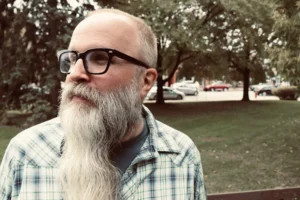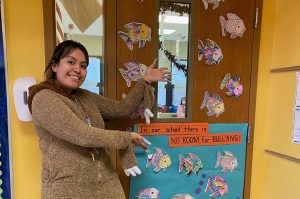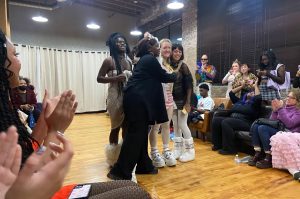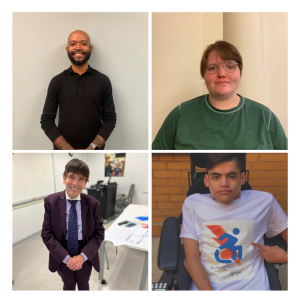
A metal bird cage rests upon a woman’s head, her bare chest exposed, a wink in her eye and her left hand over her heart.
Around her, in an array of bold and bright colors, beautiful orange monarch butterflies flutter, escaping from the cage and creating a heart like shape. A black border outlines this image and Diane Green adds the finished piece to the collection of art work she’s made during her stay at the hospital.
Green, 57, is a Chicago artist staying at the Loyola Hospital for the next few days as neurologists run tests to make sure her seizures are only coming from one side of her brain. These tests are protocol for patients with epilepsy that elect to have the brain surgery Green will be undergoing this month, and has been raising money on the crowdfunding site Go Fund Me to support herself while she recovers.
“It’s been a wild ride,” says Green with a slight southern drawl in her voice, a box of paint and art supplies all over the hospital room. “I’ve been pretty much a punk my whole life. I don’t mean that in a bad way. I create my own way of going.”
From touring with the all girl rock band “The Hellcats” getting sober and starting a nonprofit art therapy program, Green has been through a lot in the last few decades. However, despite all the ups and downs that she’s experienced, one thing has been constant for her: no matter what, everything she’s been able to accomplish has required creativity and strength.
Art captured Green’s attention at a very early age. As a child growing up in Memphis, Tennessee, Green would construct paper dolls and was always finding new ways to express her creativity. By the time she reached college she found her true calling – painting – and received a Bachelor’s Degree in Fine Arts from Memphis College of Art (known as the Memphis Academy of Art today).

Green spent the next decade in Memphis, painting, dancing, writing music and touring with her band “The Hell Cats.” The band released two records and began to make a name for themselves. It was during one of their tours that a music fan from Chicago, saw The Hellcats play and became infatuated with Green.
After hearing rumors about how “this guy in Chicago has a huge crush on her,” Green decided to go for it and left Memphis, as well as the “The Hell Cats,” to pursue a relationship with him in Chicago. After a brief courtship, the two ended up getting married in 1990, and within a couple of years had two children. While everything seemed to be coming together nicely, the two were a disastrous duo.
One Friday in the Fall of 1997, Green and an old friend from Memphis got together for drinks. After a fight with her husband who had refused to take her to see Patti Smith with him, Green needed to blow off some steam. Her and her friend kept drinking and drinking to the point that Green describes as an “insane amount of wine.”
Green felt ill the next day. She was drifting in and out of consciousness and she knew something wasn’t right. Still fuzzy on the details from the night before, Green decided to call the friend she had been drinking with to get some clarification.
“You fell and hit your head,” said her friend on the other end of the line. “Don’t you remember?”
“Oh my god, I did?” replied Green in shock, unable to remember anything. She knew that the pain she was experiencing wasn’t normal.
Green’s husband refused to take her to get medical attention and insisted she was “just hung over.” On Sunday, her brother-in-law agreed to take her to the hospital, and when he arrived to pick her up blood was dripping from her nose.
Everything in Green’s vision was turning white by the time she got to the emergency room at Northwestern Hospital. She couldn’t hear anything. She couldn’t feel anything. The next thing she knew, she was being laid down on a gurney, a nurse rushed to her side with a giant syringe, and she was out.
The following day, Green woke up in a hospital bed. Feeling the closest to death she’s ever been, as though there was a “10 ton steel block on top of her,” Green was semi-consciousness but saw her mother and sister standing in the room. This wasn’t the first time that her family had come to her rescue. As an active user of drugs and alcohol Green had found herself in jail and the hospital many times before. However, this time was different. “That’s when I realized, all that in one millisecond, I can’t drink anymore if I want to stay alive,” says Green.
Green was diagnosed with temporal lobe epilepsy due to a traumatic brain injury and stayed in the hospital until May. The months that followed were a blur.
It took about a year for Green to fully recover. At this time she was having minimal seizures, but they would often leave her fatigued throughout the day. Despite Green’s infirmity, her husband was still partying and drinking heavily.
“I kicked him to the curb and it was just me and my kids,” says Green about her now ex-husband. “I started on a new road of taking care of myself and total sobriety,” which because of the traumatic experience with her brain injury turned out to be a relatively easy and an instant change of habit. However, life threw her another curve ball.
“Everything was rocking and rolling then suddenly the seizures started getting worse,” says Green. She decided to take her children to Memphis to live with her sister while she stayed in Chicago to get her life back on track. Although it was difficult for her, she was able to give them the home life they deserved while she recovered from her injury.
While her kids were in Memphis, Green registered with a temp agency and began working desk jobs, which, when didn’t fit her artistic nature. With each click of the keyboard, Green was reminded of how much office work wasn’t for her. One day while working one of the “boring desk jobs,” she decided that she had enough. She knew that The Art Institute of Chicago had a school in the city, and after doing a bit of research, she found herself interested in their Art Therapy masters program.
She immersed herself in the program and created the non-profit organization Museum of Universal Self Expression, also known as MUSE, while she was there. After receiving her masters degree in 2004, Green felt that she was ready to bring her kids back to Chicago. “I missed them so much, I really wanted them back up here,” says Green.**

Today, Green is relaxing in her home in Pilsen. Her significant other of 16 years, Bob Buchholz, 56, organizes her art supplies as a fresh pot of coffee brews in the kitchen. Art work lines the walls of her home, each one with a story of its own. “This one is from before the brain injury,” says Green, pointing out an extra-large landscape painting with mesmerizing figures painted in a child-like fashion.
Green’s seizures started getting significantly worse in 2010. While she used to get by with only having a couple a month after she was first diagnosed with epilepsy, she now can have upwards to two a day. Green has complex partial seizures, which put her in a trance like state and can last up to 30 minutes. They leave her fatigued, confused and unable to do simple tasks, such as drive, which she misses terribly. She’s now on medications to suppress the seizures, but brain surgery seems like the most viable option at this point.
“Whatever aspects of your brain or the electricity that swirls around in your head, there’s a crack and it can’t continue the flow so it turns into a seizure every so often,” says Green who turned to Go Fund Me to help raise money to support her during her surgery. While Medicaid is paying for the actual surgery, the recovery period, which can take up to a year, will prevent Green from working.
“A lot of artists have had epilepsy of one type or another. They say Van Gogh, Lewis Carroll, Georgia O’Keefe and Michelangelo had it too. It’s heartening I’m in good company,” writes Green on her Go Fund Me campaign page titled “Diane’s Brain Storm – Surgery!” Needless to say, with a month into the campaign, and having reached $8,649 of her $9,550 goal, with 88 donations to date, Green is on track to reaching her goal.
To thank those who donate, Green is sending each one of them a print of an original piece of her artwork. For those who donate higher amounts, she’s painting original pieces specifically for them.
The best part about the surgery? While she may still have to take one type of medication, if all goes well, there’s a 70 percent chance that Green won’t have seizures anymore.
Just as he has for the last 16 years of her life, Buchholz will be there to support her. “Find somebody else,” says Green. “As hard as it may feel at first, it’s good to find somebody else. So, you know, the more you isolate the worst it’s going to feel.”
Luckily, Buchholz is that “somebody,” for Green. From driving her to doctors appointments, helping her with daily tasks in her life and artistically influencing one another, the couple maintains a strong connection.
Green looks at him with her striking yellow-brown eyes and a smile on her face. “Brain surgery,” she states. “It’s not rocket science.” The two of them burst into laughter.
“We’re just soulmates and connected at the hip for life,” Buccholz says. “If you love someone you’d do anything for them, and really, anything. It’s really that simple. I keep telling her though that, ‘when you get better there’s going to come a point that you’re going to be holding the drool bucket for me. It’ll be payback time!”
With the possibility of the seizures being done, Green has great plans for “after the surgery.” After the recovery, which is likely to take six months to a year, she hopes to refocus her time on MUSE. The nonprofit, which has since taken a hiatus due to Green’s lack of funds and time, is something that Green feels passionate about restarting. Having faced so many obstacles herself, Green has reaped the benefits that art therapy can provide when done in an open and expressive environment. She’s specifically excited for the possibility to work with the Epilepsy Foundation and build an art therapy program for them under MUSE.
Aside from that, Green’s other primary goal will naturally be to focus on her artwork. With side effects from her medication leaving her fatigued, moody and depressed, among other things, there has been a change in her art since the seizures began.
“It’s no coincidence that most people as a whole really don’t become successful until they’re like in their 50s or 60s because they’ve been laying the groundwork for decades,” says Buchholz. “I believe that after the brain surgery, and with her art she’s been doing it so long, is that all it takes is the right person to buy it or the right gallery representation.”

In the mean time though, Green will continue to prepare for her surgery and imagine the possibilities of life after epilepsy.
“Once you put good faith in what you’re working with, things will work out just the way they’re supposed to,” says Green as she sorts through her hospital art work, the translucent face of the bird cage head woman peering up at her. Soon, just like the monarch butterflies being set free from the cage upon the woman’s head, Green will undergo her own metamorphosis, or maybe she’s already had one. Perhaps now is just her time to show that she too can fly freely.











Be First to Comment